
computer fundamentals, what is computer, computer graphics, computer, computer engineering, computer architecture, about computer, computer technology, computer education, introduction to computer, computer warehouse, computer books, computer language, latest computer technology, what is a computer, introduction of computer, networking, computer price list, computer peripherals, computer configuration… , computer fundamentals pdf free download parts software & hardware 12 notes, class 12 informatics practices notes, computer fundamentals pdf free download parts software & hardware class 12, computer fundamentals pdf free download parts software & hardware class 12 notes, class 12 computer fundamentals pdf free download parts software & hardware, note informatics practices,
Computer is an advanced electronic device that takes raw data as input from the user and processes these data under the control of set of instructions (called program) and gives the result (output) and saves output for the future use. It can process both numerical and non-numerical (arithmetic and logical) calculations. It works the principle of I-P-O Cycle

A computer has four functions: |
||
a. |
accepts data |
Input |
b. |
processes data |
Processing |
c. |
produces output |
output |
d. |
stores results |
Storage |
(While designing the Difference Engine and Analytical Engine Charles Babage has given the concept of these four units, Hence he is known as “Father of Computer”.)
Input is the raw information or facts entered into a computer from the input devices. It is the collection of letters, numbers, images etc.
Process is the operation of data as per given instruction. It is totally internal process of the computer system.
Output is the processed data given by computer after data processing. Output is also called Result or information . We can save these results in the storage devices for the future use.
The components of the Computer System are:-
| 1. | Hardwaer |
| 2. | Softweer |
| 3 | Firmwaer |
| 4. | Livewear |
• Hardware = Internal Devices + Peripheral Devices All physical parts of the computer (or everything that we can touch) are known as Hardware.
• Software = Programs Software gives "intelligence" to the computer.
• USER = Person, who operates computer.
All the physical and tangible components of Computer are called Hardware. In other words all the components that we can touch come under the category of Hardware eg Keyboard, Mouse
Software is a set of instructions or a program that enables a hardware to run. Without the use of software a hardware cannot work.eg. Windows 8, Photoshop, MS Office etc.
Instructions written/embedded on a hardware are known as firmware e.g., BIOS instruction on ROM chip are called Firmware.
Persons or the users, using Computers in day to day activity are known as liveware.
The first generation computers used Vacuum tubes & Machine language was used for giving the instructions. These computer were large in size & their programming was difficult task. The electricity consumption was very high. Some computers of this generation are ENIAC, EDVAC, EDSAC& UNIVAC-1.
In 2nd generation computers, Vacuum tubes were replaced by Transistors. They required only 1/10 of power required by Vacuum tubes. This generation computers generated less heat & were reliable. The first operating system developed in this generation.
The 3rd generation computers replaced transistors with Integrated circuit known as chip. From Small scale integrated circuits which had 10 transistors per chip, technology developed to MSI circuits with 100 transistors per chip. These computers were smaller, faster & more reliable. High level languages invented in this generation.
LSI & VLSI were used in this generation. As a result microprocessors came into existence. The computers using this technology known to be Micro Computers. High capacity hard disk were invented. There is great development in data communication.
Fifth generation computing devices, based on artificial intelligence, are still in development, though there are some applications, such as voice recognition, that are being used today. The use of parallel processing and superconductors is helping to make artificial intelligence a reality. Quantum computation and molecular and nanotechnology will radically change the face of computers in years to come
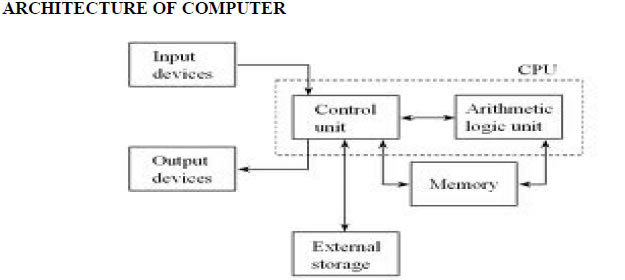
Those devices which help to enter data into computer system. Eg. Keyboard, Mouse, Touch screen,Bar Code Reader, Scanner, MICR, OMR etc.

Those devices which help to display the processed information.Eg. Monitor, Printer, Plotter, Projector
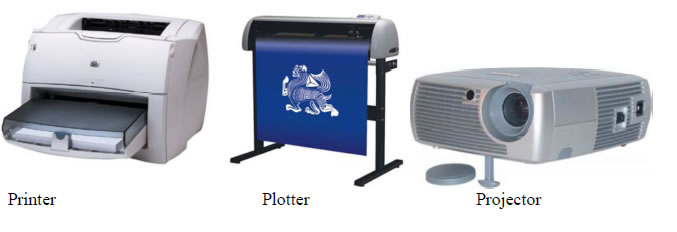
The main component to make a computer operate is the computer chip or microprocessor. This is referred to as the Central Processing Unit (CPU). It is also known as Brain of computer. It performs arithmetic and logic operations. The CPU (Central Processing Unit) is the device that interprets and executes instructions.

Memory:
It facilitates the remembrance power to computer system. It refers to the physical devices used to store programs (sequences of instructions) or data (e.g. program state information) on a temporary or permanent basis for use in a computer or other digital electronic device.
1. Primary Memory
2. Secondary Memory
The term primary memory is used for the information in physical systems which are fast (i.e. RAM), as a distinction from secondary memory, which are physical devices for program and data storage which are slow to access but offer higher memory capacity. Primary memory stored on secondary memory is called virtual memory.
PrimaryMemory can be categorized as:- |
|
| 1. | Volatile Memory (RAM) |
| 2. | Non-Volatile Memory(ROM) |
Volatile memory (RAM) |
|
Volatile memory is computer memory that requires power to maintain the stored information. RAM stands for Random Access Memory. The data is primarily stored on RAM. This is also known as Read-Write memory as both the operation can take place on it. It is volatile in nature because as soon as the power is off its contents are also removed. It can be of two types:- |
| 1. Static RAM or SRAM. |
| 2. Dynamic RAM or DRAM |
| SRAM retains its contents as long as the power is connected and is easy to interface to but uses six transistors per bit. |

Dynamic RAM is more complicated to interface to and control and needs regular refresh cycles to prevent its contents being lost. However, DRAM uses only one transistor and a capacitor per bit, allowing it to reach much higher densities and, with more bits on a memory chip, be much cheaper per bit. SRAM is not worthwhile for desktop system memory, where DRAM dominates, but is used for their cache memories..
Non-volatile memory is computer memory that can retain the stored information even when not powered. ROM stands for Read Only Memory. As the name suggests we can perform only read operation on ROM. It is permanent in nature. In ROM booting instructions for computer in the form of firmware are stored
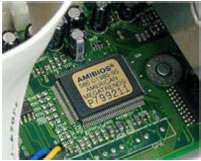
Cache memory is an intermediate between RAM and processor. It is very fast. Cache memory is random access memory (RAM) that a computer microprocessor can access more quickly than it can access regular RAM. As the microprocessor processes data, it looks first in the cache memory and if it finds the data there (from a previous reading of data), it does not have to do the more timeconsuming reading of data from larger memory.
Secondary Memory: |
|
| A. | Hard Disk (Local Disk) |
| B. | Optical Disks: CD-R, CD-RW, DVD-R, DVD-RW |
| C. | Floppy Disks |
| D. | Memory Cards |
| E. | External Hard Disk |
| F. | Blu Ray Disk |

Blu-ray (not Blue-ray) also known as Blu-ray Disc (BD), is the name of a new optical disc format. The format offers more than five times the storage capacity of traditional DVDs and can hold up to 25GB on a single-layer disc and 50GB on a dual-layer disc. While current optical disc technologies such as DVD, DVD±R, DVD±RW, and DVD-RAM rely on a red laser to read and write data, the new format uses a blue-violet laser instead, hence the name Blu-ray.
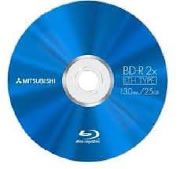
Units of Memory: |
||
1 bit |
= |
0 or 1 |
1 Byte |
= |
8 bit |
1 Nibble |
= |
4 bit |
1 Kilo Byte |
= |
1024 Byte= 210 Byte |
1 Mega Byte |
= |
1024 KB= 210 KB |
1 Gega Byte |
= |
1024 MB= 210 MB |
1 Tera Byte |
= |
1024 GB= 210 GB |
1 Peta Byte |
= |
1024 TB= 210 TB |
1 Exa Byte |
= |
1024 PB= 210 PB |
1 Zetta Byte |
= |
1024 EB= 210EB |
1 Yotta Byte |
= |
1024 ZB= 210ZKB |
On the basis of working principle
An analog computer is a form of computer that uses continuous physical phenomena such as electrical, mechanical, or hydraulic quantities to model the problem being solved. Eg: Thermometer, Speedometer, Petrol pump indicator, Multimeter

A computer that performs calculations and logical operations with quantities represented as digits, usually in the binary number system.
A combination of computers those are capable of inputting and outputting in both digital and analog signals. A hybrid computer system setup offers a cost effective method of performing complex simulations. The instruments used in medical science lies in this category.
The fastest type of computer. Supercomputers are very expensive and are employed for specialized applications that require immense amounts of mathematical calculations. For example, weather forecasting requires a supercomputer. Other uses of supercomputers include animated graphics, fluid dynamic calculations, nuclear energy research, and petroleum exploration. PARAM, Pace & Flosolver are the supercomputer made in India.
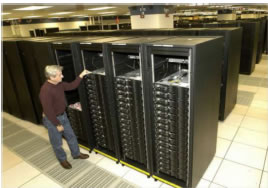
A very large and expensive computer capable of supporting hundreds, or even thousands, of users simultaneously. In the hierarchy that starts with a simple microprocessor (in watches, for example) at the bottom and moves to supercomputers at the top, mainframes are just below supercomputers. In some ways, mainframes are more powerful than supercomputers because they support more simultaneous programs. But supercomputers can execute a single program faster than a mainframe.
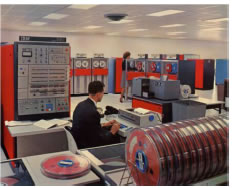
A midsized computer. In size and power, minicomputers lie between workstations and mainframes. In the past decade, the distinction between large minicomputers and small mainframes has blurred, however, as has the distinction between small minicomputers and workstations. But in general, a minicomputer is a multiprocessing system capable of supporting from 4 to about 200 users simultaneously. Generally, servers are comes in this category.
i. Desktop Computer: a personal or micro-mini computer sufficient to fit on a desk. ii. Laptop Computer: a portable computer complete with an integrated screen and keyboard. It is generally smaller in size than a desktop computer and larger than a notebook computer. iii. Palmtop Computer/Digital Diary /Notebook /PDAs: a hand-sized computer. Palmtops have no keyboard but the screen serves both as an input and output device.
A terminal or desktop computer in a network. In this context, workstation is just a generic term for a user’s machine (client machine) in contrast to a "server" or "mainframe."

As specified earlier Software, simply are the computer programs. The instructions given to the computer in the form of a program is called Software. Software is the set of programs, which are used for different purposes. All the programs used in computer to perform specific task is called Software.
a) Operating System Software DOS, Windows XP, Windows Vista, Unix/Linux, MAC/OS X etc. b) Utility Software Windows Explorer (File/Folder Management), Compression Tool, Anti-Virus Utilities, Disk Defragmentation, Disk Clean, BackUp, WinZip, WinRAR etc… c) Language Processors Compiler, Interpreter and Assembler
a) General Application Software Ms. Office 2003, Ms. Office 2007, Macromedia (Dreamweaver, Flash, Freehand), Adobe (PageMaker, PhotoShop) b) Tailored or Customized Software School Management system, Inventory Management System, Payroll system, financial system etc.
Operating system is an interface between hardware and user which is responsible for the management and coordination of activities and the sharing of the resources of a computer. It hosts the several applications that run on a computer and handles the operations of computer hardware.
Functions of operating System: |
|
| • | Processor Management |
| • | Memory Management |
| • | File Management |
| • | Device Management |
| Types of Operating System: | |
| • | Real-time Operating System: It is a multitasking operating system that aims at executing real-time applications. Example of Use: e.g. control of nuclear power plants, oil refining, chemical processing and traffic control systems, air |
| • | Single User Systems: Provides a platform for only one user at a time. They are popularly associated with Desk Top operating system which run on standalone systems where no user accounts are required. Example: DOS. |
| • | Multi User Systems: Provides regulated access for a number of users by maintaining a database of known users. Refers to computer systems that support two or more simultaneous users. Another term for multi-user is time sharing. Ex: All mainframes are multi-user systems. Example: Unix |
| • | Multi-tasking and Single-tasking Operating Systems: When a single program is allowed to run at a time, the system is grouped under the single-tasking system category, while in case the operating system allows for execution of multiple tasks at a time, it is classified as a multi-tasking operating system. |
| • | Distributed Operating System: An operating system that manages a group of independent computers and makes them appear to be a single computer is known as a distributed operating system. Distributed computations are carried out on more than one machine. When computers in a group work in cooperation, they make a distributed system. |
Pronounced uoo-niks, a popular multi-user, multitasking operating system developed at Bell Labs in the early 1970s. UNIX was one of the first operating systems to be written in a highlevel programming language, namely C. This meant that it could be installed on virtually any computer for which a C compiler existed.
Pronounced lee-nucks or lih-nucks. A freely-distributable open source operating system that runs on a number of hardware platforms. The Linux kernel was developed mainly by Linus Torvalds and it is based on Unix. Because it’s free, and because it runs on many platforms, including PCs and Macintoshes, Linux has become an extremely popular alternative to proprietary operating systems.
Microsoft Windows is a series of graphical interface operating systems developed, marketed, and sold by Microsoft. Microsoft introduced an operating environment named Windows on November 20, 1985 as an add-on to MS-DOS in response to the growing interest in graphical user interfaces (GUIs). Microsoft Windows came to dominate the world’s personal computer market with over 90% market share, overtaking Mac OS, which had been introduced in 1984.The most recent client version of Windows is Windows 7; the most recent server version is Windows Server 2008 R2; the most recent mobile version is Windows Phone 7.5.
Solaris is a Unix operating system originally developed by Sun Microsystems. It superseded their earlier SunOS in 1993. Oracle Solaris, as it is now known, has been owned by Oracle Corporation since Oracle’s acquisition of Sun in January 2010. BOSS: BOSS (Bharat Operating System Solutions) GNU/Linux distribution developed by C-DAC (Centre for Development of Advanced Computing) derived from Debian for enhancing the use of Free/ Open Source Software throughout India. This release aims more at the security part and comes with an easy to use application to harden your Desktop.
Mobile OS: A mobile operating system, also called a mobile OS, is an operating system that is specifically designed to run on mobile devices such as mobile phones, smartphones, PDAs, tablet computers and other handheld devices. The mobile operating system is the software platform on top of which other programs, called application programs, can run on mobile devices.
Android is a Linux-based mobile phone operating system developed by Google. Android is unique because Google is actively developing the platform but giving it away for free to hardware manufacturers and phone carriers who want to use Android on their devices.
Symbian is a mobile operating system (OS) targeted at mobile phones that offers a high-level of integration with communication and personal information management (PIM) functionality. Symbian OS combines middleware with wireless communications through an integrated mailbox and the integration of Java and PIM functionality (agenda and contacts). The Symbian OS is open for third-party development by independent software vendors, enterprise IT departments, network operators and Symbian OS licensees.
Since a computer hardware is capable of understanding only machine level instructions, So it is necessary to convert the HLL into Machine Level Language. There are three Language processors:
It is translator which converts the HLL language into machine language in one go. A Source program in High Level Language get converted into Object Program in Machine Level Language.
It is a translator which converts and executes the HLL language code line by line. It takes one statement of HLL and converts it into machine code which is immediately executed. It eliminate the need of separate compilation/run. However, It is slow in processing as compare to compiler.
It translate the assembly language into machine code.
A microprocessor is a semiconductor chip, which is manufactured using the Large Scale integration (LSI) or Very Large Scale Integration (VLSI), which comprises Arithmetic Logic Unit, Control unit and Central Processing Unit (CPU) fabricated on a single chip.
A register is a very small amount of very fast memory that is built into the CPU (central processing unit) in order to speed up its operations by providing quick access to commonly used values. All data must be represented in a register before it can be processed. For example, if two numbers are to be multiplied, both numbers must be in registers, and the result is also placed in a register.
A collection of wires through which data is transmitted from one part of a computer to another. You can think of a bus as a highway on which data travels within a computer. When used in reference to personal computers, the term bus usually refers to internal bus. This is a bus that connects all the internal computer components to the CPU and main memory. All buses consist of two parts -- an address bus and a data bus. The data bus transfers actual data whereas the address bus transfers information about where the data should go. The control bus is used by the CPU to direct and monitor the actions of the other functional areas of the computer. It is used to transmit a variety of individual signals (read, write, interrupt, acknowledge, and so forth) necessary to control and coordinate the operations of the computer.
The size of a bus, known as its width, is important because it determines how much data can be transmitted at one time. For example, a 16-bit bus can transmit 16 bits of data, whereas a 32-bit bus can transmit 32 bits

Also called clock rate, the speed at which a microprocessor executes instructions. Every computer contains an internal clock that regulates the rate at which instructions are executed and synchronizes all the various computer components. The CPU requires a fixed number of clock ticks (or clock cycles) to execute each instruction. The faster the clock, the more instructions the CPU can execute per second. Clock speeds are expressed in megahertz (MHz) or gigahertz ((GHz).
16 bit Microprocessor: It indicates the width of the registers. A 16-bit microprocessor can process data and memory addresses that are represented by 16 bits. Eg. 8086 processor
32 bit Microprocessor: It indicates the width of the registers. A 32-bit microprocessor can process data and memory addresses that are represented by 32 bits. Eg. Intel 80386 processor, Intel 80486
64 bit Microprocessor: It indicates the width of the registers; a special high-speed storage area within the CPU. A 32-bit microprocessor can process data and memory addresses that are represented by 32 bits. e.g. Pentium dual core, Core 2 duo.
128 bit Microprocessor: It indicates the width of the registers. A 128-bit microprocessor can process data and memory addresses that are represented by 128 bits. e.g. Intel core i7
1. RISC system has reduced number of instructions. 2. Performs only basic functions. 3. All HLL support is done in software. 4. All operations are register to register.
1. A large and varied instruction set. 2. Performs basic as well as complex functions. 3. All HLL support is done in Hardware. 4. Memory to memory addressing mode
It is a 64-bit microprocessor instruction set, jointly defined and designed by Hewlett Packard and Intel, that provides up to 128 general and floating point unit registers and uses speculative loading, predication, and explicit parallelism to accomplish its computing tasks. By comparison, current 32- bit CISC and RISC microprocessor architectures depend on 32-bit registers, branch prediction, memory latency, and implicit parallelism, which are considered a less efficient approach in micro architecture design.
A port is an interface between the motherboard and an external device. Different types of port are available on motherboard as serial port, parallel port, PS/2 port, USB port, SCSI port etc.
A serial port transmit data one bit at a time. Typically on older PCs, a modem, mouse, or keyboard would be connected via serial ports. Serial cables are cheaper to make than parallel cables and easier to shield from interference. It is also called communication port.
It supports parallel communication i.e. it can send several bits simultaneously. It provides much higher data transfer speed in comparison with serial port. It is also called Line Printer Port.
It is a newer type of serial connection that is much faster than the old serial ports. USB is also much smarter and more versatile since it allows the "daisy chaining" of up to 127 USB peripherals connected to one port. It provides plug & play communication.
PS/2 ports are special ports for connecting the keyboard and mouse to some PC systems. This type of port was invented by IBM
The IEEE 1394 interface, developed in late 1980s and early 1990s by Apple as FireWire, is a serial bus interface standard for high-speed communications and isochronous realtime data transfer. The 1394 interface is comparable with USB and often those two technologies are considered together, though USB has more market share.
An IR port is a port which sends and receives infrared signals from other devices. It is a wireless type port with a limited range of 5-10ft.
Bluetooth uses short-range radio frequencies to transmit information from fixed and mobile devices. These devices must be within the range of 32 feet, or 10 meters for Bluetooth to effectively work. A Bluetooth port enables connections for Bluetooth-enabled devices for synchronizing. Typically there are two types of ports: incoming and outgoing. The incoming port enables the device to receive connections from Bluetooth devices while the outgoing port makes connections to Bluetooth devices.
ASCII ( American standards code for information interchange): ASCII code is most widely used alphanumeric code used in computers. It is a 8- bit code, and so it has 28 =256 possible code groups. It represents all of the standard keyboard characters as well as control functions such as Return & Linefeed functions.
ISCII (Indian standards code for information interchange) : To use the Indian language on computers, ISCII codes are used. It is an 8-bit code capable of coding 256 characters. ISCII code retains all ASCII characters and offers coding for Indian scripts also.
Unicode: It is a universal coding standard which provides a unique number for every character, no matter what the platform, no matter what the program, no matter what the language. Unicode is a 16-bit code capable of representing more than 65000 characters. The coding for ASCII characters remain the same in Unicode. It can represent almost all the languages of the world.
Copyright @ ncerthelp.com A free educational website for CBSE, ICSE and UP board.